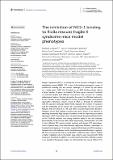Por favor, use este identificador para citar o enlazar a este item:
http://hdl.handle.net/10261/285755COMPARTIR / EXPORTAR:
 SHARE SHARE
 CORE
BASE CORE
BASE
|
|
| Visualizar otros formatos: MARC | Dublin Core | RDF | ORE | MODS | METS | DIDL | DATACITE | |

| Título: | The inhibition of NCS-1 binding to Ric8a rescues fragile X syndrome mice model phenotypes |
Autor: | Cogram, Patricia; Fernández-Beltrán, Luis C.; Casarejos, María José; Sánchez-Yepes, Sonia; Rodríguez-Martín, Eulalia; García-Rubia, Alfonso CSIC; Sánchez-Barrena, María José CSIC ORCID; Gil, Carmen CSIC ORCID ; Martínez Gil, Ana CSIC ORCID ; Mansilla, Alicia CSIC ORCID | Palabras clave: | Fragile X syndrome Ncs-1, Ric8a Dopamine Protein-protein interaction inhibitor Fmr1 knockout |
Fecha de publicación: | 16-nov-2022 | Editor: | Frontiers Media | Citación: | Frontiers in Neuroscience 16: 1007531 (2022) | Resumen: | Fragile X syndrome (FXS) is caused by the loss of function of Fragile X mental retardation protein (FMRP). FXS is one of the leading monogenic causes of intellectual disability (ID) and autism. Although it is caused by the failure of a single gene, FMRP that functions as an RNA binding protein affects a large number of genes secondarily. All these genes represent hundreds of potential targets and different mechanisms that account for multiple pathological features, thereby hampering the search for effective treatments. In this scenario, it seems desirable to reorient therapies toward more general approaches. Neuronal calcium sensor 1 (NCS-1), through its interaction with the guanine-exchange factor Ric8a, regulates the number of synapses and the probability of the release of a neurotransmitter, the two neuronal features that are altered in FXS and other neurodevelopmental disorders. Inhibitors of the NCS-1/Ric8a complex have been shown to be effective in restoring abnormally high synapse numbers as well as improving associative learning in FMRP mutant flies. Here, we demonstrate that phenothiazine FD44, an NCS-1/Ric8a inhibitor, has strong inhibition ability in situ and sufficient bioavailability in the mouse brain. More importantly, administration of FD44 to two different FXS mouse models restores well-known FXS phenotypes, such as hyperactivity, associative learning, aggressive behavior, stereotype, or impaired social approach. It has been suggested that dopamine (DA) may play a relevant role in the behavior and in neurodevelopmental disorders in general. We have measured DA and its metabolites in different brain regions, finding a higher metabolic rate in the limbic area, which is also restored with FD44 treatment. Therefore, in addition to confirming that the NCS-1/Ric8a complex is an excellent therapeutic target, we demonstrate the rescue effect of its inhibitor on the behavior of cognitive and autistic FXS mice and show DA metabolism as a FXS biochemical disease marker. | Descripción: | 15 p.-6 fig. | Versión del editor: | https://doi.org/10.3389/fnins.2022.1007531 | URI: | http://hdl.handle.net/10261/285755 | DOI: | 10.3389/fnins.2022.1007531 | ISSN: | 1662-4548 | E-ISSN: | 1662-453X |
| Aparece en las colecciones: | (CIB) Artículos (IQF) Artículos |
Ficheros en este ítem:
| Fichero | Descripción | Tamaño | Formato | |
|---|---|---|---|---|
| frontiers in neurosciences_cogram_2022.pdf | Artículo principal | 2 MB | Adobe PDF |  Visualizar/Abrir |
CORE Recommender
SCOPUSTM
Citations
1
checked on 24-abr-2024
WEB OF SCIENCETM
Citations
1
checked on 19-feb-2024
Page view(s)
173
checked on 26-abr-2024
Download(s)
49
checked on 26-abr-2024
Google ScholarTM
Check
Altmetric
Altmetric
Este item está licenciado bajo una Licencia Creative Commons



